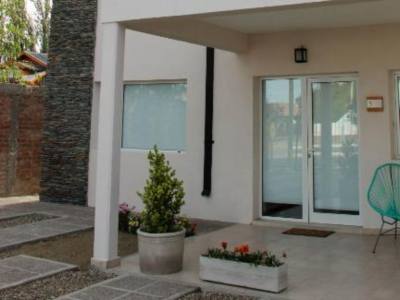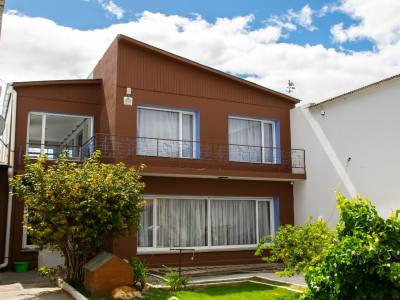
It is located just 30 km away to the South of Sarmiento accessed through a gravel road. This provincial natural monument is a forest from the Cenozoic Era. That means it is approximately 65 million years old.
It is located just 30 km away to the South of Sarmiento accessed through a gravel road. This provincial natural monument is a forest from the Cenozoic Era. That means it is approximately 65 million years old. These petrified trees, witnesses of Prehistory, make up an indescribable beauty given by the hardness of the rock, the color of the different geologic strata and the heavy silence of respect for nature. Its petrified logs are part of the result of the effect of millions of years on the wood. At the beginning of the Tertiary Era, the Andes Mountain Range rose and thus, prevented the humidity from the Pacific from getting through. At the same time, eruptions were produced and the ash deposits spread around giving way to a slow process of transformation of these logs into stone. There are plenty of logs in the volcanic sediments of its soil. Some of them have a significant size and it has been established that they were originated in the Lower Tertiary Period (Paleocene). The tiny grains of pollen of these sediments were studied in order to reconstruct the kind of vegetation dominating the area with extreme detail. The plants used to belong to a temperate to tropical warm kind of weather with significant humidity.

The Salamanquense is the first testimony of the Atlantic Ocean marine entrance in this area. It is approximately 65,000,000 years old with primitive species of the coniferous family (though it is possible to observe rests of palm trees) that give an idea of a former sub equatorial region with abundant woods and lagoons inhabited by a varied and numerous fauna. We can confirm this last information due to the Paleontologic findings in the Department of Sarmiento. Currently, the landscape is desolate and impressive due to the arid loneliness of this steppe but it is certain that this area was once a forest hard to imagine today.
Petrification Process

The petrified wood is the transmutation of the organic substance into rock through a process that can be described as follows: At the beginning of the Tertiary Era, the Andes Mountain Range starts rising and prevents the currents of humid air from the Pacific to the Atlantic from passing. There are volcanic eruptions simultaneously and the ashes spread around giving way to the slow process of organic transformation, which consists in absorption, impregnation, substitution and mutation of the molecular nature keeping its exterior appearance. The outcrops of these extraordinary petrified logs, the Moonlike landscape and the surrounding hills with varied colors allow visitors to observe the different geographical strata which make this place a unique attraction that cannot be missed. The Petrified Wood Provincial Park of Sarmiento has a park ranger service. Open hours: ask at the tourist information office. At the moment, there is an integral plan in which all the institutions interested in the protection and exploitation of the park participate.

 The Salamanquense is the first testimony of the Atlantic Ocean marine entrance in this area. It is approximately 65,000,000 years old with primitive species of the coniferous family (though it is possible to observe rests of palm trees) that give an idea of a former sub equatorial region with abundant woods and lagoons inhabited by a varied and numerous fauna. We can confirm this last information due to the Paleontologic findings in the Department of Sarmiento. Currently, the landscape is desolate and impressive due to the arid loneliness of this steppe but it is certain that this area was once a forest hard to imagine today.
The Salamanquense is the first testimony of the Atlantic Ocean marine entrance in this area. It is approximately 65,000,000 years old with primitive species of the coniferous family (though it is possible to observe rests of palm trees) that give an idea of a former sub equatorial region with abundant woods and lagoons inhabited by a varied and numerous fauna. We can confirm this last information due to the Paleontologic findings in the Department of Sarmiento. Currently, the landscape is desolate and impressive due to the arid loneliness of this steppe but it is certain that this area was once a forest hard to imagine today. 











